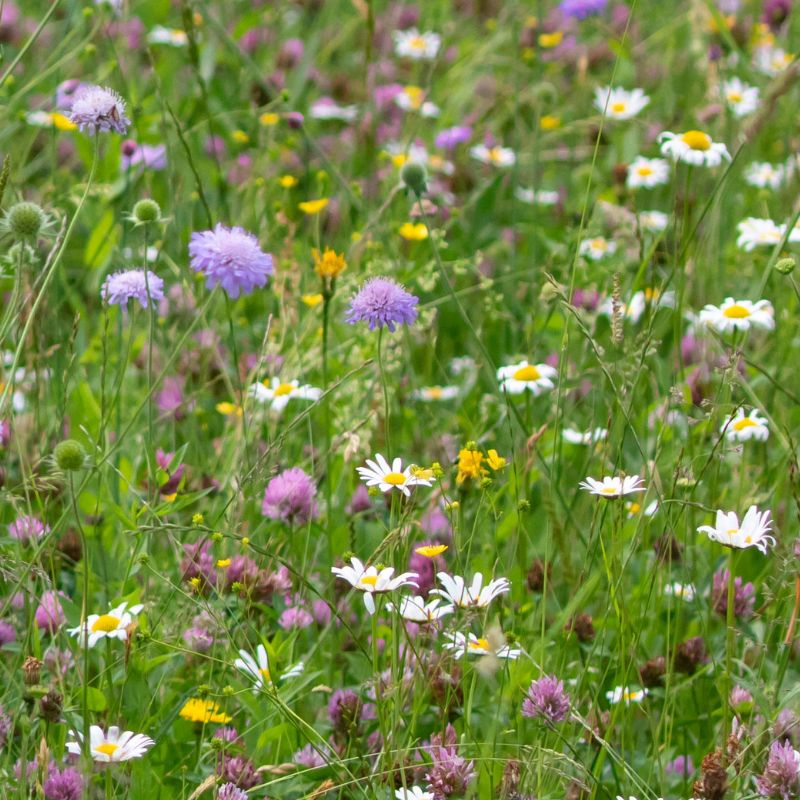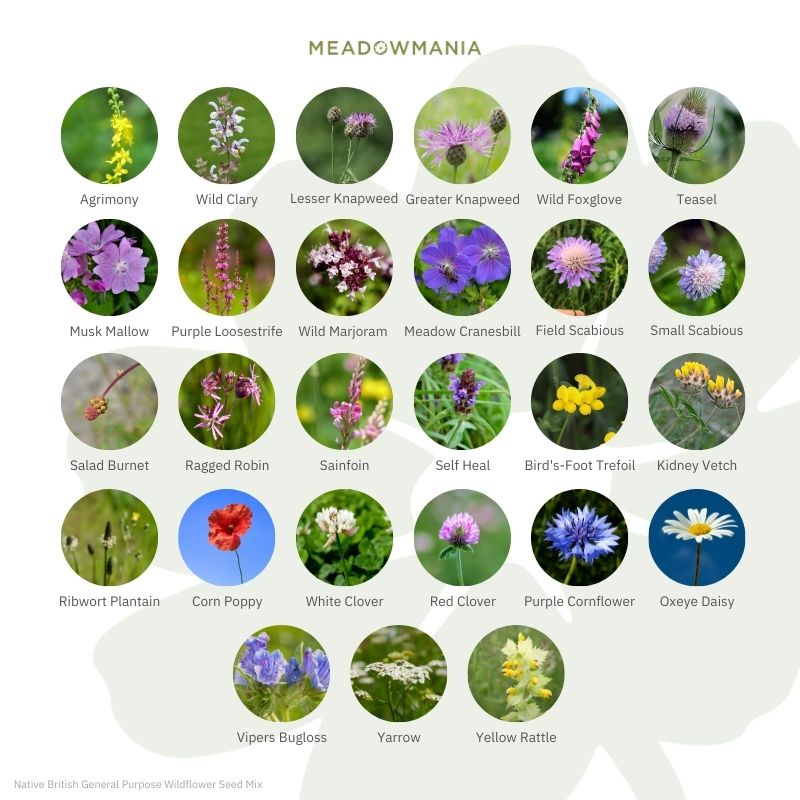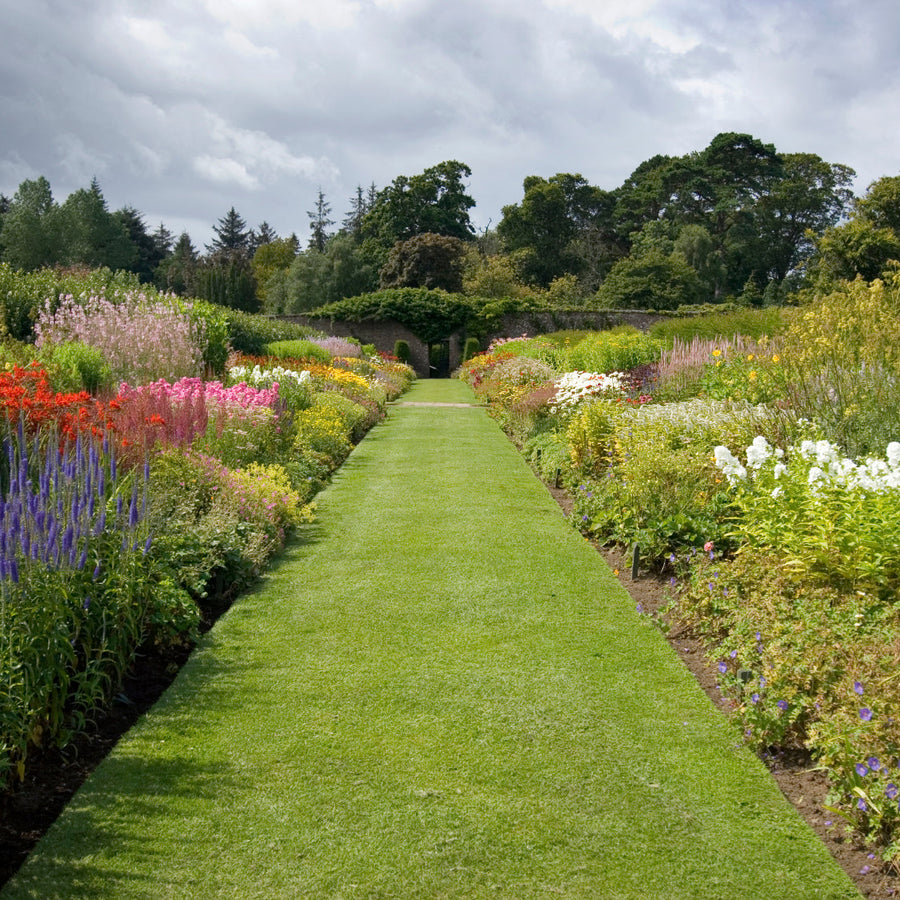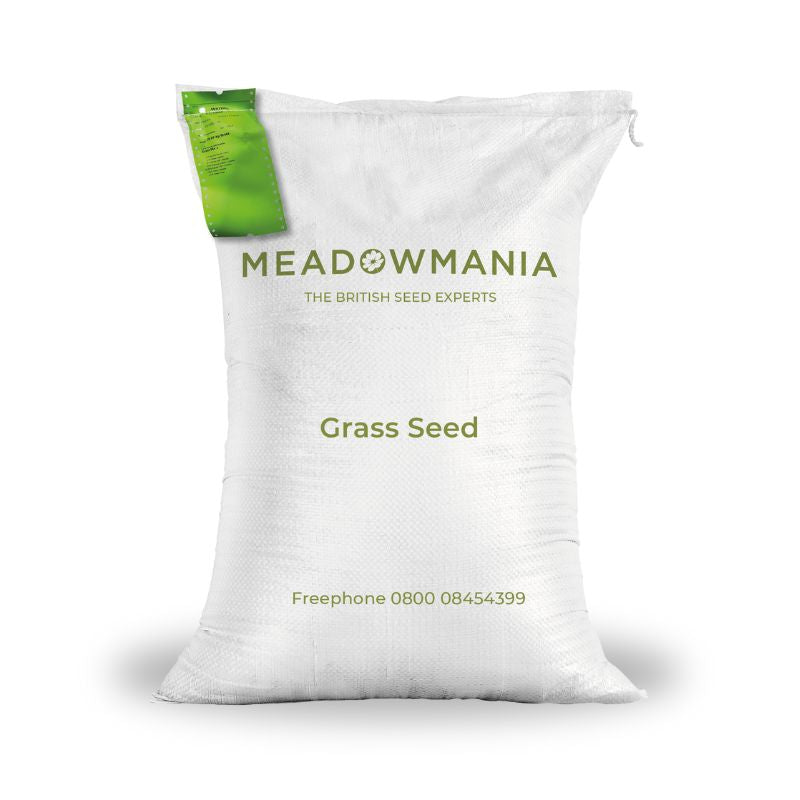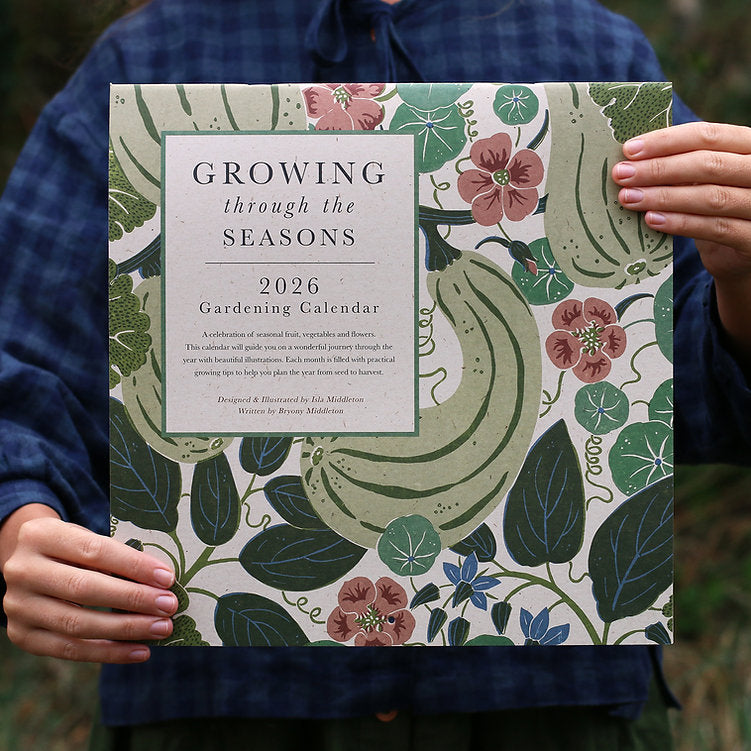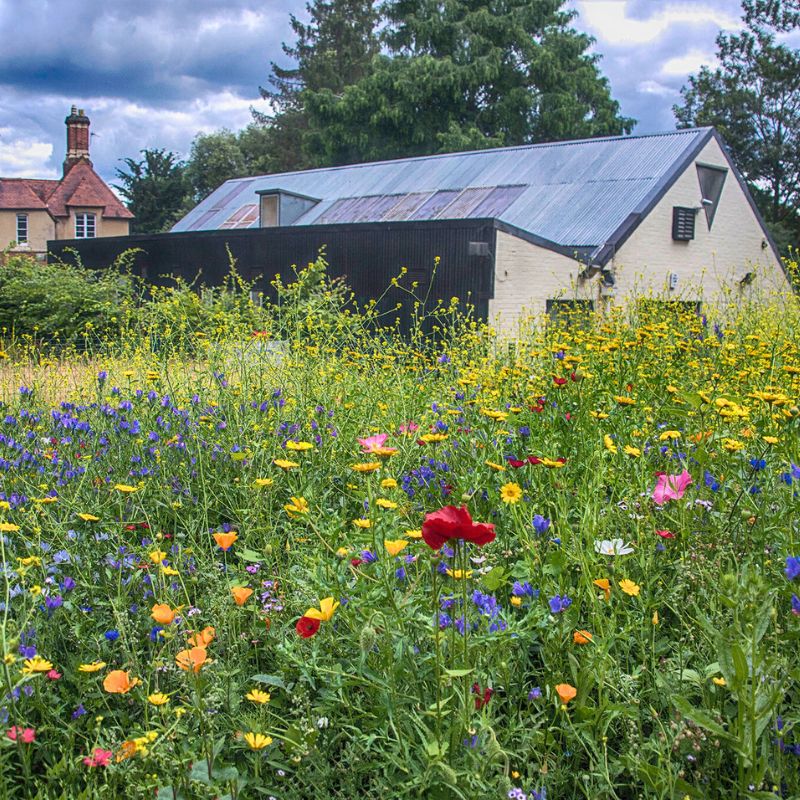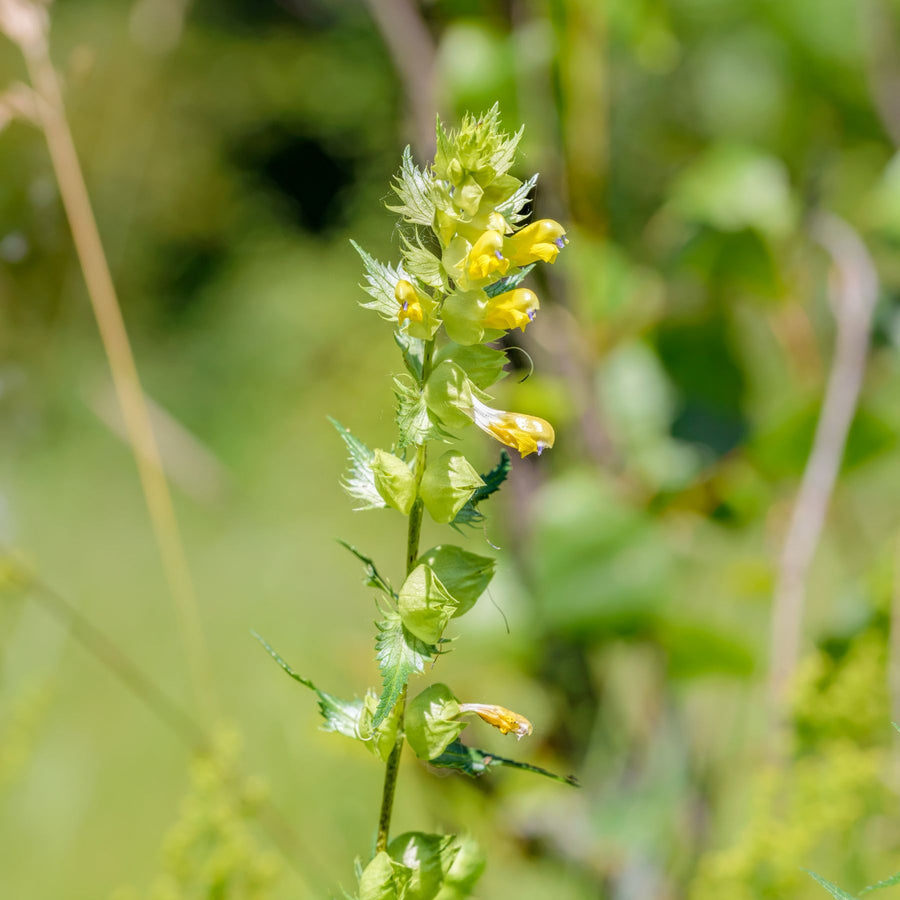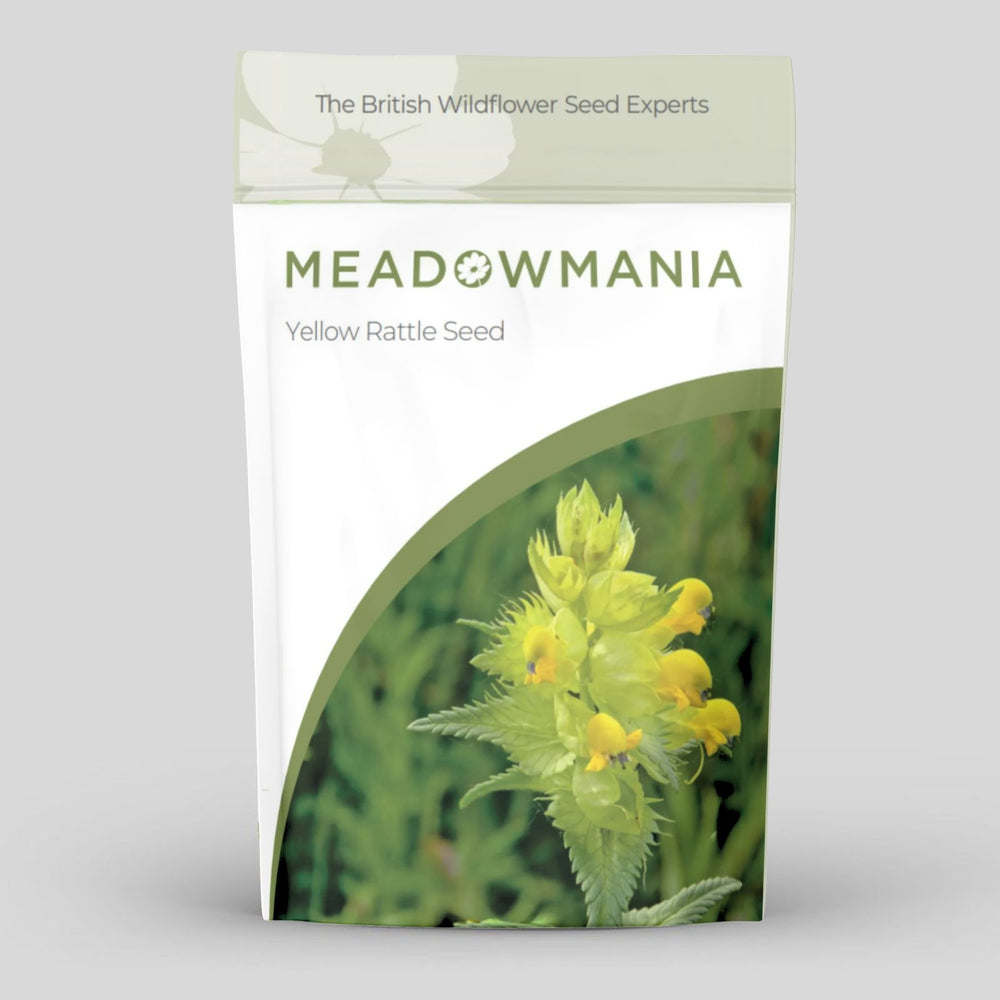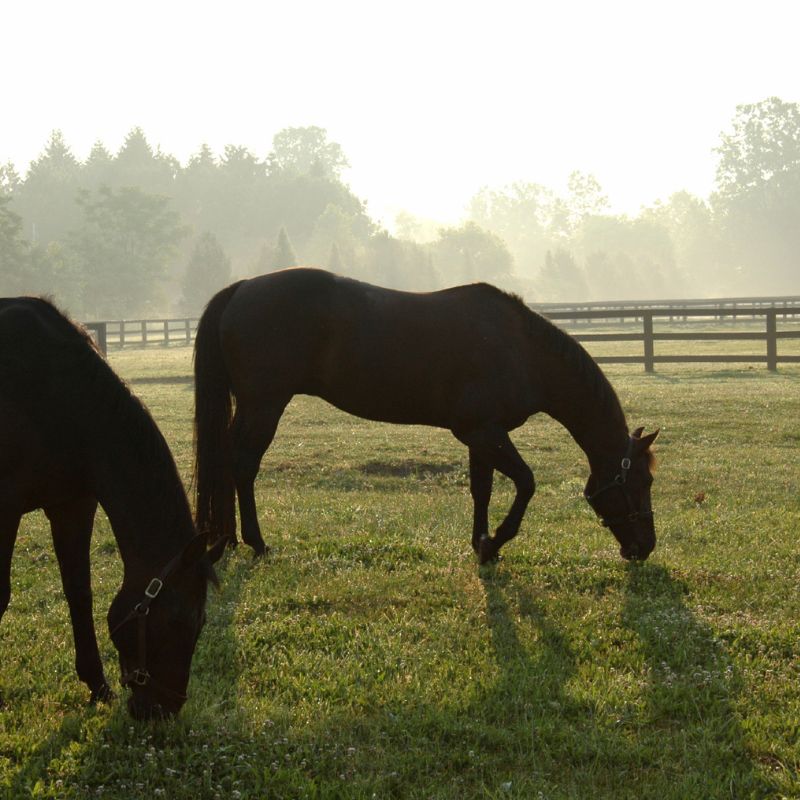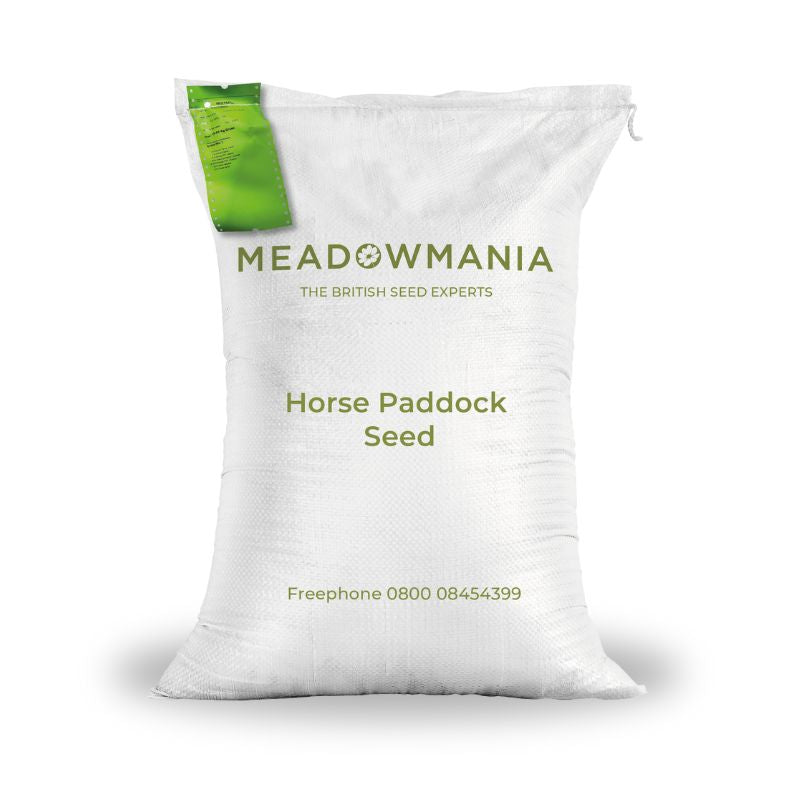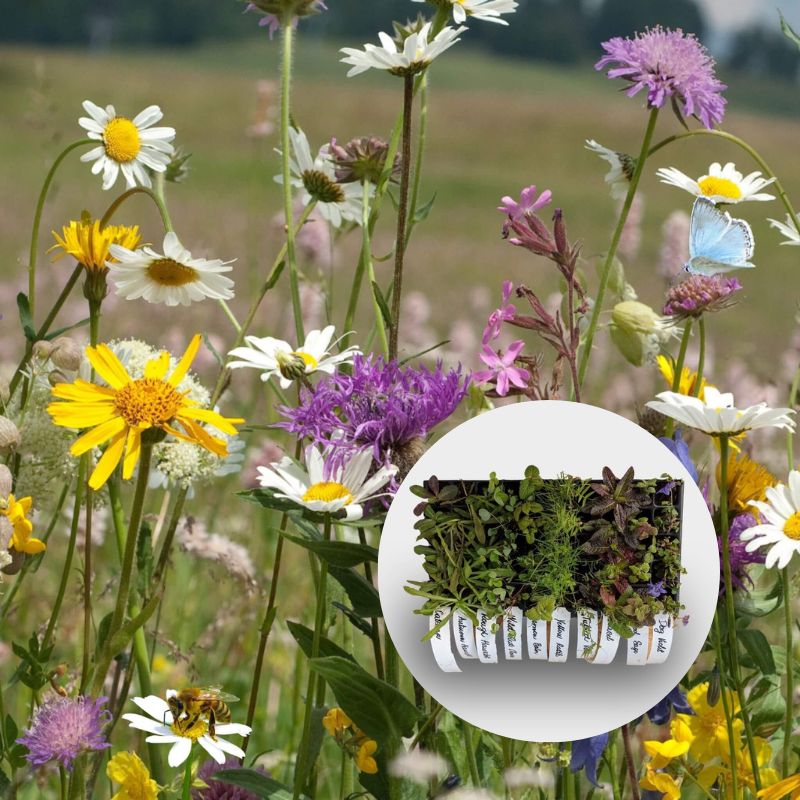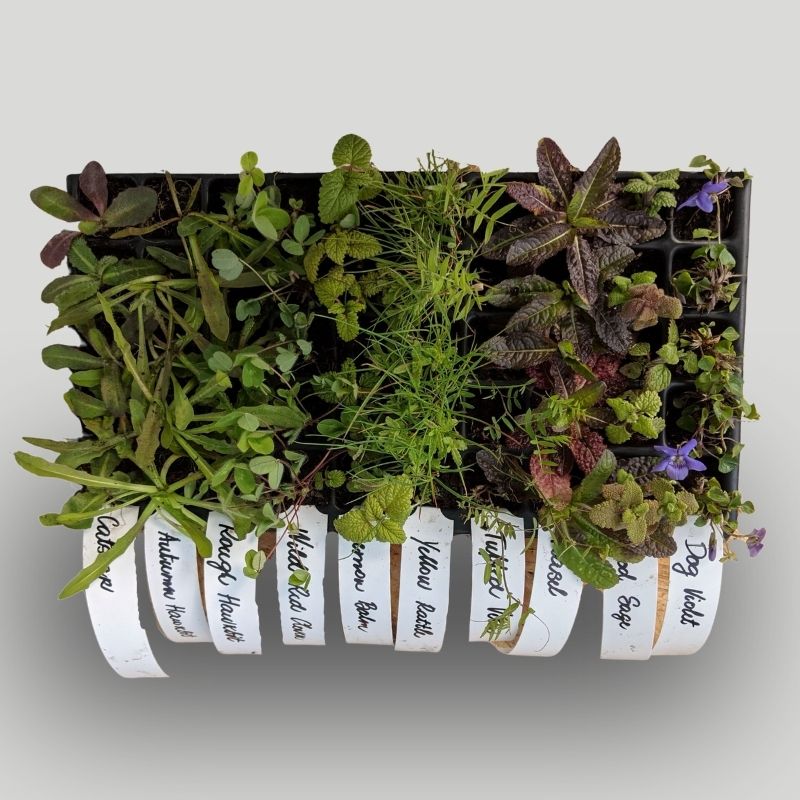
Rewilding for Equine Wellness: Why & How to Add Biodiversity to Your Horse Paddock
Traditional horse paddocks, often dominated by perennial ryegrass, can lack the variety and vitality needed to support your horse’s health and wellbeing. Uniform swards offer limited nutrition, poor soil health, and little mental stimulation—far from the diverse environments horses evolved to thrive in.
With thoughtful management, these spaces can be transformed into biodiverse, multi-species habitats that promote better gut health, natural grazing behaviour, and calmer, more content horses. At the same time, they support native wildlife, regenerate soil, and build climate resilience.
A biodiverse paddock isn’t just better for nature—it’s better for your horse.
Why Biodiversity Matters in Paddocks
Equine Wellness
A biodiverse paddock is key to your horse’s physical and mental health. By introducing a varied mix of grasses, herbs, and wildflowers, you provide a more natural diet that supports better gut health, boosts immune function, and promotes overall vitality. This diversity also encourages natural grazing behaviours, reducing stress and boredom-related behaviours, such as pacing or cribbing.
The Equine Benefits of a Biodiverse Paddock:
-
🐴 A More Natural Diet
Herbs, wildflowers, and diverse grasses provide a broader nutritional profile, rich in natural minerals and bioactive compounds that support gut health, metabolic balance, and overall wellness—ideal for laminitis-prone or sensitive horses. -
🐴 Mental Stimulation & Enrichment
A varied paddock encourages natural grazing behaviours, curiosity, and movement. This helps reduce boredom, anxiety, and stress, which are commonly seen in uniform, overgrazed pastures. -
🐴 Improved Gut Health
A greater diversity of plants supports a healthier gut microbiome, aiding in better digestion. Species like chicory and plantain offer natural anthelmintic and anti-inflammatory properties. -
🐴 Behavioural Balance
The stimulation from a more natural environment helps horses feel calmer and more content. The ability to self-select from a variety of plants mimics natural foraging, reducing frustration and improving overall behavioural balance. -
🐴 Natural Shelter & Comfort
Native hedgerows and trees provide shade, windbreaks, and a more comfortable living space, offering essential protection, especially during extreme weather conditions.
Additional Benefits for the Land & Environment
Ecosystem Support
Healthy, diverse paddocks not only benefit your horses but also create a thriving environment for local wildlife. By attracting pollinators, birds, and insects, your paddock helps support broader biodiversity.
Soil Health
Diverse pastures improve soil structure and fertility, encouraging deeper root systems and creating a balanced, nutrient-rich environment that benefits your horses’ grazing.
Climate Resilience
Biodiverse pastures are more resilient to extreme weather conditions. They recover faster from droughts or floods, store carbon, and contribute to long-term environmental sustainability.
This guide outlines practical steps to create a healthier, more enriching environment for your horse by rewilding your paddock. By replacing ryegrass, introducing wildflowers, planting hedgerows, and improving soil health, you can transform your paddocks into vibrant, multi-species habitats that provide your horse with a more natural diet, reduce boredom, and promote better physical and mental well-being.
1. Rethink the Sward: Encourage Plant Diversity
Perennial ryegrass is commonly used in horse paddocks due to its fast growth and durability, but it offers limited ecological value and can pose health risks to horses. Its dominance creates a monoculture that suppresses other plant species, reducing biodiversity and contributing to poor soil structure over time. Moreover, perennial ryegrass is typically high in water-soluble carbohydrates (sugars), which can increase the risk of laminitis—a painful and potentially debilitating condition in horses. To learn more about the role of high-sugar grasses in laminitis, see our blog: Understanding Laminitis In Horses.
By transitioning to a more diverse, ryegrass-free sward made up of grasses like timothy, cocksfoot, and meadow fescue, along with deep-rooting herbs such as plantain, yarrow, and chicory, paddocks can better support soil health, improve forage variety, and enhance the overall ecosystem. These low-sugar, high-fibre species not only help mimic the natural grazing patterns of horses but also provide more balanced nutrition, reduce parasite loads, and increase drought resistance due to deeper root systems.
Comparison Table: Perennial Ryegrass vs. Diverse Sward Species
| Feature | Perennial Ryegrass | Diverse Sward Species (e.g. timothy, cocksfoot, plantain, chicory, yarrow) |
|---|---|---|
| Nutritional Content | High in sugars (WSC), can increase laminitis risk | Lower in sugars, higher in fibre, more balanced for horse diets |
| Biodiversity Support | Low – monoculture, supports few insect or wildlife species | High – supports pollinators, birds, and beneficial soil organisms |
| Soil Health | Shallow-rooted, contributes to compaction and erosion | Deep-rooted species improve soil structure, aeration, and nutrient cycling |
| Drought Resistance | Poor – shallow roots dry out quickly | Good – deep roots access water from lower soil layers |
| Grazing Suitability | Fast-growing, but overgrazing can lead to bare patches | Slower to establish but more resilient and longer-lasting under rotational grazing |
| Parasite Control | No natural anthelmintic properties | Some species (e.g. chicory, sainfoin) have natural worm-reducing effects |
| Wildlife Value | Limited – offers minimal habitat or forage for insects | Excellent – attracts bees, butterflies, birds, and improves overall habitat value |
| Aesthetic Value | Uniform green sward, low diversity | Visually diverse and more natural-looking, with seasonal flowering plants |
| Management Needs | High fertiliser demand, frequent mowing | Lower input required, thrives on less fertile soil |
Actions:
- Sow diverse grass mixes (with species including timothy, cocksfoot, crested dog’s-tail, and fescues), such as Meadowmania's Millie Mix or Gold Standard Natural Paddock Grass Seed Mix which provide varied root depths and food sources for insects.
- Include horse-safe wildflowers and herbs such as:
- Yarrow (Achillea millefolium): supports pollinators and aids digestion in horses.
- Plantain (Plantago lanceolata): high in minerals and palatable.
- Chicory (Cichorium intybus): deep-rooted and drought-tolerant.
- Sheep’s burnet, self-heal, birds-foot trefoil: support pollinators and enhance sward resilience.
- Avoid poisonous species like ragwort, bracken, and foxglove.
2. Sow Wildflowers and Herbs in Horse Fields and Margins
Adding wildflower strips or meadows or beneficial herbs to your horse fields or margins is a simple and effective way to boost biodiversity, attract pollinators, and enhance the visual appeal of your land. Wildflowers thrive best in low-fertility soils, so start by choosing an area away from high manure or fertiliser inputs—fencelines, field corners, and rested buffer strips are ideal. Prepare the soil by removing existing vegetation and lightly scarifying or harrowing the surface. Select a UK-Native Horse-Safe Wildflower Mix containing species like meadowsweet, salad burnet, kidney vetch, and lady's bedstraw, or a Mixed Herbs for Horses Mixture containing herbs such as sainfoin, sheep's parsley, ribgrass and fenugreek. These species support pollinators, offer medicinal and nutritional value to horses, and improve sward resilience.
Actions:
- Sow in spring (March-May) or late summer/autumn (August-October) for best establishment.
- Use approximately 2 grams of seed per square metre when sowing wildflower mixes.
- Roll or lightly tread in the seeds to ensure good seed-to-soil contact - avoid burying them too deeply.
- Once established, cut the area once or twice per year to control grasses and allow flowers to thrive.
- Remove cuttings after mowing to keep soil fertility low and encourage seedling growth.
- Exclude horses from wildflower strips until plants are well rooted.
- Once mature, allow limited, seasonal access for horses to forage and explore for enrichment.
Statistic: Flower margins can support up to 40 species of insect pollinators per square metre.
3. Create Rotational or Rested Grazing Areas
Continuous grazing discourages the establishment of diverse plant species and places excessive pressure on soil structure, leading to compaction, erosion, and nutrient depletion. In contrast, implementing a rotational grazing system—where paddocks are divided and rested between grazing periods—allows grasses and herbs to recover, promotes deeper root development, and supports a wider range of plant species. Rested areas give time for wildflowers and beneficial herbs to establish and reseed naturally, increasing biodiversity and forage variety. This approach not only sustains healthier, more resilient pastures but also improves forage quality and reduces the risk of overgrazing-related issues such as bare patches, weed invasion, and mud accumulation. Additionally, by breaking the life cycle of internal parasites, rotational grazing can contribute to better equine health with less reliance on chemical wormers. Overall, giving your paddocks time to rest is one of the simplest yet most effective ways to build long-term soil health, enhance biodiversity, and promote sustainable land use.
Actions:
- Rotate grazing to allow plants to recover and flowers to set seed.
- Designate “sacrifice” or “herbal ley” paddocks: allow some fields to rest completely for a season and be reseeded with a species-rich mix.
- Leave buffer zones or field margins ungrazed through spring/summer to allow insects, wildflowers, and ground-nesting birds to thrive.
4. Introduce Horse-Friendly Hedging

Hedgerows in horse paddocks offer significant health benefits for your horses. They provide natural forage such as leaves, hips, and berries from safe species like hawthorn and hazel, supporting a more varied and nutrient-rich diet. The dense cover and shade they offer help protect horses from extreme weather, while also providing sensory enrichment, encouraging natural exploration and reducing stress. In addition to these horse-focused benefits, hedgerows enhance biodiversity by serving as vital habitats for wildlife like birds, bats, pollinators, and small mammals. They also improve the environment by buffering wind, reducing soil erosion, and supporting beneficial insects that promote pasture health. By planting or restoring native hedgerows, you create a richer, more engaging environment for your horses while enhancing ecological connectivity and habitat diversity.
✅ Safe Hedgerow Species for Horses
These native or naturalised species are generally non-toxic and provide excellent benefits such as forage, shelter, and enrichment for both horses and wildlife:
| Species (Common Name + Binomial Name) | Benefits (Horse-Friendly) |
|---|
| Hawthorn (Crataegus monogyna) | Excellent hedging; safe for horses; supports biodiversity; flowers for pollinators; edible haws. |
| Field Maple (Acer campestre) | Non-toxic to horses; provides shade; good for hedgerows; supports insects and birds. |
| Dog Rose (Rosa canina) | Produces rose hips rich in vitamin C; safe for horses; attractive flowers; supports wildlife. |
| Dogwood (Cornus sanguinea) | Safe in moderation; good for hedgerows; attracts insects and birds with flowers and berries. |
| Wild Pear (Pyrus pyraster) | Non-toxic; provides shelter and seasonal fruit; attracts pollinators and birds. |
| Sweet Briar Rose (Rosa rubiginosa) | Edible rose hips; thorny shelter for wildlife; fragrant foliage; horse-safe. |
| Hornbeam (Carpinus betulus) | Hardy hedging tree; non-toxic; tolerates heavy pruning; provides shade and shelter. |
| Hazel (Corylus avellana) | Produces edible nuts (for wildlife, not horses); excellent for coppicing; supports biodiversity. |
❌ Toxic Hedgerow Species to Avoid Around Horses
These plants are dangerous or potentially fatal to horses and should not be planted in or near horse-accessible areas. Even small amounts can cause serious health problems.
| Species | Toxic Part(s) | Effect on Horses |
|---|---|---|
| Yew (Taxus baccata) | All parts, especially leaves | Extremely toxic – can cause sudden death even in small amounts |
| Laburnum (Laburnum anagyroides) | All parts, especially seed pods | Can cause vomiting, convulsions, respiratory failure |
| Laurel (Prunus laurocerasus) | Leaves and seeds | Contains cyanogenic compounds – can cause difficulty breathing and collapse |
| Privet (Ligustrum spp.) | Leaves and berries | Gastrointestinal upset, possible neurological effects |
| Sycamore (Acer pseudoplatanus) | Seeds ("helicopters"), seedlings | Can cause Atypical Myopathy – muscle damage, weakness, often fatal |
| Oak (Quercus spp.) | Acorns, young leaves | High tannin levels – may cause colic, constipation, and kidney damage |
| Cherry (Prunus spp.) | Wilted leaves and bark | Contains cyanide compounds – can lead to respiratory failure |
Management Tips:
- Allow hedges to flower and fruit – trimming no more than once every 2–3 years outside the nesting season (March–August).
- Establish hedgerow trees (e.g. oak, rowan) for added structure and wildlife value.
Bonus: Mature trees increase soil carbon storage by over 50% compared to treeless pasture.
5. Add Microhabitats
Simple features within your paddock can play a powerful role in supporting native wildlife by offering essential shelter, breeding sites, and movement corridors. Elements such as log piles, stone stacks, shallow ponds, and unmown grass corners may seem small, but they create microhabitats that benefit insects, amphibians, small mammals, and birds. These low-maintenance additions enhance ecological complexity, improve the health of the surrounding environment, and encourage natural pest control by attracting beneficial species like hedgehogs, frogs, and predatory beetles. Integrating such wildlife-friendly features into your paddock layout not only strengthens biodiversity but also fosters a more balanced and resilient ecosystem that thrives alongside your horses.
Ideas include:
- Log piles or stone heaps for beetles and amphibians.
- Shallow ponds or scrapes (protected from horses) to support dragonflies, frogs, and birds.
- Wildlife corridors using rough grass strips or uncut hedgerows that connect habitats across your land.
6. Enhance Soil and Reduce Inputs
Healthy soil is the foundation of a thriving, biodiverse paddock ecosystem. When managed well, soil supports a rich web of microbial life, stores carbon, retains water, and enables a wide variety of plants to flourish—creating better forage for horses and better habitat for wildlife. However, the overuse of fertilisers, herbicides, and intensive grazing can strip soil of its natural structure and microbial activity, leading to compaction, nutrient imbalances, and an increase in invasive weeds. By adopting soil-friendly practices such as reducing chemical inputs, allowing rest periods, adding organic matter, and encouraging deep-rooted plants, you can restore soil vitality and build a more sustainable and resilient paddock from the ground up.
Actions:
- Minimise fertiliser and herbicide use.
- Test soil to avoid over-liming or nutrient imbalance.
- Use compost or well-rotted manure rather than chemical inputs.
- Encourage dung beetles, which improve nutrient cycling and reduce parasite burdens.
Conclusion: A Living Landscape for Horses and Wildlife
Transforming your horse paddock into a biodiverse haven goes beyond planting flowers—it’s about creating a healthy, natural environment that directly benefits your horses. By enhancing plant diversity, improving soil health, and introducing features like wildflower margins, hedgerows, and herbal leys, you’re fostering a space that supports both your horse’s physical and mental well-being.
Small changes, like replacing ryegrass with a varied, low-sugar sward or leaving an unmown corner, can significantly reduce the risk of health issues like laminitis and promote natural grazing behaviours. These changes also provide the sensory enrichment horses instinctively seek, encouraging movement, curiosity, and foraging. A biodiverse paddock supports a more natural lifestyle for horses, helping to keep them healthy, content, and engaged. The best part is that once established, the natural ecosystem takes over, improving pasture quality, building resilience, and creating a vibrant, self-sustaining environment that benefits both horses and wildlife.
Explore our complete range of perennial ryegrass-free paddock mixtures and horse-friendly hedging options on our website—designed to help you create a healthier, more natural environment for your horses.


